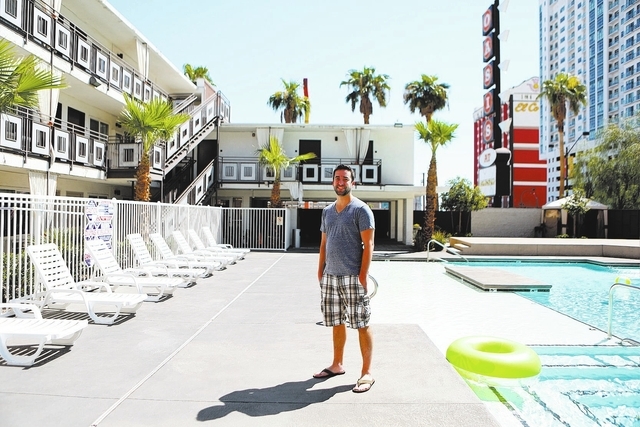Resort real estate market still in a holding pattern
Las Vegas has a commercial real estate market like no other.
Sure, you have your traditional office, industrial and retail space. But you also have one of the largest resort districts in the world, and that sector is a market unto itself. That means it’s on a slightly different path toward recovery, say local experts in gaming real estate.
For one thing, the resort sector is more volatile than other types of commercial real estate, said Josh Smith, a commercial real estate consultant for gaming and co-founder of Colliers International Gaming Group in Las Vegas. Operators turn over their customers on a daily basis, rather than locking in their “tenants” with leases that run five to 15 years. Gaming is also vulnerable to immediate fallout from economic trouble, because operators rely on consumers’ discretionary income. And for better or for worse, gaming ties Las Vegas directly into the economy of the rest of the world, Smith said.
Right now, being keyed in to the global economy isn’t a bad thing. That’s because just as the world’s economy has been on the comeback trail, so has gaming. Where 2009, 2010 and 2011 brought hard times, 2012 and 2013 meant “real growth” in some parts of the economy, Smith said.
“2013 was the year we saw the recovery start to happen, particularly in the last couple of quarters,” Smith said. “We started to hear about strong demand indices. We’ve seen a lot of increased demand coming into 2014, and occupancies and rates are expected to be higher.”
Those expectations haven’t yet translated into huge amounts of investment.
Sales of gaming properties were slow in 2013, but that’s not necessarily a bad thing. The properties that did turn over were mostly smaller, limited-service places, said John Stater, research manager at Colliers International. Downtown’s Gold Spike is an example: Zappos CEO Tony Hsieh’s Downtown Project bought the 112-room property in April, with plans to redevelop it into a nongaming project. Taking those kinds of properties off the hospitality market helps constrain inventory as the market tries to recover, and that means less competition for operators still trying to survive, Stater said.
But there’s still enough competition to keep a lid on major megaresort development.
“With gaming real estate, we’re definitely not ready for another boom,” Stater said.
What the market is prepared for is investment that reflects a gaming sector in transition. The industry has long been moving away from gambling revenue and toward more sales from entertainment, shopping and dining, and that’s affecting how development looks early in the recovery. Retail and entertainment projects are underway between New York-New York and Monte Carlo, and at Harrah’s, Bally’s and Treasure Island.
“They’re all looking at maximizing retail as a response to people having a little less money to play with,” Stater said. “People are different than they were 30 or 40 years ago. They don’t like risk as much. If they play a table game, they may walk away having lost all of their money. Or they can have a guaranteed good time if they spend on retail or entertainment. Resorts are tapping into that.”
As operators wait and see how visitors receive their new developments, don’t expect a lot of investment sales of gaming real estate in coming months. The exception? Downtown, which will be a “bright spot simply because of the amount of money pouring into it, and all of the attention and energy surrounding what (Hsieh) is doing there,” Stater said. “That will keep a lot of people probing downtown to see if there are opportunities for them there.”
Where will deals stay the slowest? Probably in the suburbs, because with no major, new residential developments planned in 2014, there may not be enough additional rooftops to spur added locals’ casinos.
“The locals market truly survives off of people who can drive to their properties in 15 minutes,” Smith said. “You won’t see more growth in locals markets until employment and housing numbers come back.”
Although the overall economy is looking up, 2014 will mostly be a bridge to better times that aren’t here yet, local experts said.
Sure, consumer confidence is on the mend, and local tourism is at or near record levels. Smith said he’s bullish on the market, and it’s an ideal time for “opportunistic investors” to come into the market and get good returns.
But the recovery is far from complete.
Said Stater: “It’s sort of like after you’ve had the flu. It’s that next morning, when you take the first step on your feet. You can get up and get moving again. I think that’s where we are in 2014. The market has had a couple of years of recovery, and now it’s getting back into the development phase and testing its strength. If all goes well, 2015 will probably be a pretty productive year.”
■ Activity is picking up at the proposed Park Highlands master plan in North Las Vegas.
A few weeks after KBS Strategic Opportunity REIT JV announced that it spent $20 million to finish assembling 1,265 acres, a private New York real estate firm said it had obtained financing to build lots in the community.
The Lightstone Group said on Dec. 19 that it had closed on development funds through Stearns Bank, a regional bank based in Phoenix.
Lightstone didn’t say how much funding it received, or how many lots it would develop in Park Highlands. But the financing will go to building out 1,500 lots among the North Las Vegas community and three Phoenix master plans.
In a statement, Lightstone called Park Highlands “one of the few remaining large-scale development opportunities in the Las Vegas area.”
“Since early 2013, national and major local homebuilders have ramped up construction in numerous portions of the Las Vegas Valley,” the statement said.
Contact reporter Jennifer Robison at jrobison@reviewjournal.com. Follow @J_Robison1 on Twitter.






















